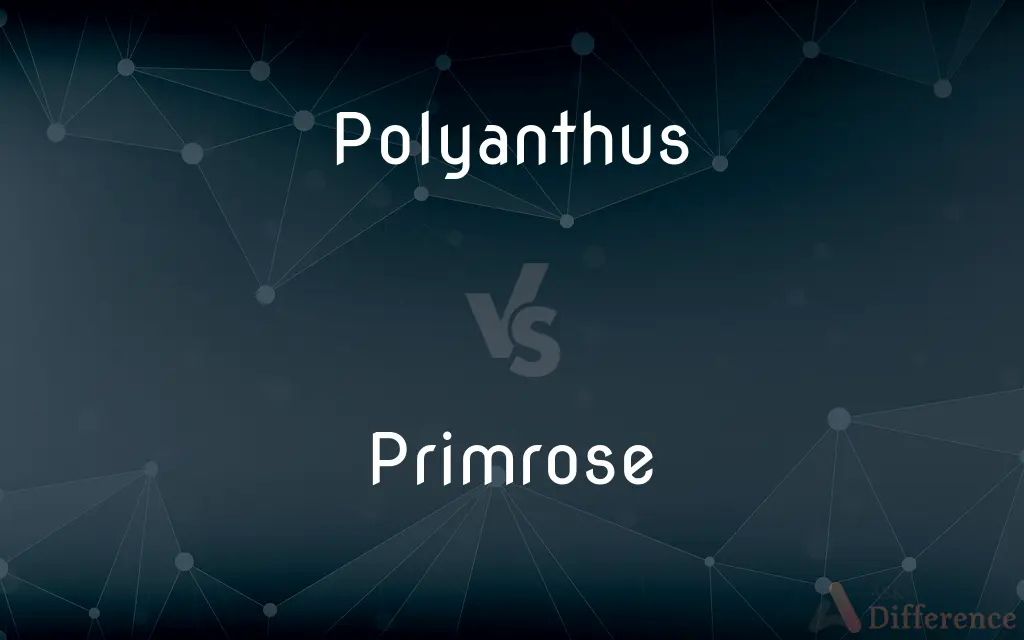Polyanthus vs. Primrose — What's the Difference?
Edited by Tayyaba Rehman — By Urooj Arif — Updated on April 9, 2024
Polyanthus thrives in partial shade, whereas primroses prefer cool, moist conditions. Primroses display single, delicate flowers closer to the foliage.

Difference Between Polyanthus and Primrose
Table of Contents
ADVERTISEMENT
Key Differences
Polyanthus, a hybrid derived from the Primula genus, is known for its vibrant, multi-colored flowers that grow in dense clusters on tall stems, making them standout additions to spring gardens. They are particularly valued for their ability to bring color to partially shaded areas. In contrast, primroses (Primula species) feature a wide range of colors but typically present with single, cup-shaped flowers growing close to the plant's rosette of leaves. Primroses are renowned for their early spring bloom, often being one of the first signs of spring in cooler climates.
Both polyanthus and primroses are popular for their bright colors and early flowering times, yet polyanthus tends to be more tolerant of wet conditions and can be found blooming in a wider variety of environments, including woodland settings and more shaded garden spots. Primroses, while also adaptable, generally prefer well-drained soil and are more commonly used in borders, underplanting, and woodland gardens.
The cultivation requirements for polyanthus and primroses overlap significantly, with both preferring cool temperatures and moist, rich soil. However, polyanthus plants may require a bit more attention to prevent crown rot in wetter conditions, a condition to which they can be more susceptible due to their dense flowering heads and longer stems. Conversely, primroses, with their more traditional growth habit, might need protection from the midday sun in warmer climates to prevent wilting.
While both flowers contribute beautifully to garden aesthetics, their differences in height, bloom structure, and growing conditions make them suitable for various garden roles. Polyanthus is often used for vertical interest in mixed borders or as eye-catching bedding plants, whereas primroses are excellent for ground cover and adding splashes of color to shady garden corners.
The cultural significance of polyanthus and primroses varies, with both flowers having a history of medicinal use and being associated with various folklore traditions. Primroses, in particular, are often linked to symbols of renewal and youth, fitting their role as one of the harbingers of spring.
ADVERTISEMENT
Comparison Chart
Flower Structure
Clustered blooms on tall stems.
Single flowers close to the foliage.
Preferred Habitat
Partial shade; tolerant of a wider range of conditions.
Cool, moist conditions; well-drained soil.
Bloom Time
Early spring.
One of the first flowers to bloom in spring.
Colors
Wide range, often vibrant and multi-colored.
Wide range, including pastels and vibrant tones.
Use in Gardens
Bedding plants, mixed borders for vertical interest.
Ground cover, borders, underplanting in woodland gardens.
Soil Preference
Moist, rich soil; can be prone to crown rot.
Prefers well-drained soil; needs protection from hot sun.
Cultural Significance
Less specific; generally appreciated for their bright spring colors.
Associated with renewal, youth, and various folklore traditions.
Compare with Definitions
Polyanthus
A hybrid of the Primula genus with clustered, vibrant flowers.
The polyanthus brightened the shaded garden bed with its colorful display.
Primrose
Features delicate, cup-shaped flowers close to the foliage.
The yellow primroses look like little suns nestled in the green leaves.
Polyanthus
Often used for bold spring displays in gardens.
I planted polyanthus along the walkway for an early splash of color.
Primrose
Prefers cool, moist environments and well-drained soil.
I ensure my primroses are planted in a spot where the soil stays moist but not waterlogged.
Polyanthus
Known for its tolerance to partial shade and moist conditions.
Polyanthus thrives under the canopy of my backyard's oak trees.
Primrose
A member of the Primula genus, known for early spring blooms.
Primroses are among the first flowers to bloom in my garden.
Polyanthus
Requires monitoring for crown rot in wet conditions.
After a rainy week, I checked the polyanthus for signs of crown rot.
Primrose
Symbolizes renewal and youth in various cultures.
I always include primroses in my spring equinox celebration as a symbol of new beginnings.
Polyanthus
Adds vertical interest in mixed borders.
The tall stems of the polyanthus added height to my garden's border.
Primrose
Used for ground cover and in woodland garden settings.
A carpet of primroses under the trees brings life to my early spring garden.
Polyanthus
Any of a group of hybrid garden primroses having clusters of variously colored flowers.
Primrose
Any of numerous plants of the genus Primula, having large basal leaves and clusters of variously colored flowers with a five-lobed bell-shaped or salverform corolla. Also called primula.
Polyanthus
A type of primula, apparently originally from a hybrid between the cowslip and the primrose, having many different-coloured flowers.
Primrose
A flowering plant of the genus Primula.
Polyanthus
The oxlip. So called because the peduncle bears a many-flowered umbel. See Oxlip. (b) A bulbous flowering plant of the genus Narcissus (Narcissus Tazetta, or Narcissus polyanthus of some authors). See Illust. of Narcissus.
Primrose
Specifically, the species Primula acaulis (syn. Primula vulgaris), also called common primrose.
Polyanthus
Florists' primroses; considered a complex hybrid derived from oxlip, cowslip, and common primrose
Primrose
A plant of the family Primulaceae.
Primrose
A plant of the genus Oenothera, better known as an evening primrose.
Primrose
A flower of a primrose plant.
Primrose
A light yellow colour.
Primrose
Of a light yellow colour.
Primrose
(intransitive) To pick primroses.
We went primrosing on Sunday and returned with a full basket.
Primrose
An early flowering plant of the genus Primula (Primula vulgaris) closely allied to the cowslip. There are several varieties, as the white-, the red-, the yellow-flowered, etc. Formerly called also primerole, primerolles.
Primrose
Of or pertaining to the primrose; of the color of a primrose; - hence, flowery; gay.
Primrose
Any of numerous short-stemmed plants of the genus Primula having tufted basal leaves and showy flowers clustered in umbels or heads
Common Curiosities
What are polyanthus and primroses commonly used for in gardening?
Polyanthus is used for vibrant, eye-catching displays in partially shaded areas, while primroses are favored for ground cover and adding early spring color.
How do polyanthus and primroses differ in appearance?
Polyanthus flowers are clustered on tall stems, offering a bold look, whereas primroses have single flowers that sit close to the foliage, creating a delicate appearance.
Can polyanthus and primroses grow in the same garden conditions?
Yes, both prefer cool, moist conditions but have different requirements regarding sunlight and soil drainage.
What special care do polyanthus plants need?
They may require extra attention to prevent crown rot, especially in very wet conditions.
Are primroses perennial?
Yes, primroses are perennials, returning each year to bloom in early spring.
Do polyanthus and primroses come in different colors?
Both offer a wide range of colors, from pastels to vibrant hues, suitable for various garden designs.
What makes polyanthus suitable for vertical garden interest?
Their tall stems and clustered blooms add height and texture to garden beds and borders.
Why are primroses associated with renewal and youth?
Their early bloom in spring symbolizes the end of winter and the beginning of new growth, embodying themes of renewal and fresh starts.
How should I protect my primroses from the midday sun?
Planting them in a location that receives morning sun and afternoon shade or using other plants to provide natural shade can protect primroses from the hot sun.
Can I plant polyanthus and primroses together?
Yes, planting them together can create a beautiful, layered floral display that takes advantage of their different heights and bloom styles.
How do I prevent crown rot in polyanthus?
Ensure good soil drainage, avoid overcrowding, and reduce watering frequency to prevent excessively wet conditions.
Share Your Discovery

Previous Comparison
Continuation vs. Continuity
Next Comparison
Rock vs. WoodAuthor Spotlight
Written by
Urooj ArifUrooj is a skilled content writer at Ask Difference, known for her exceptional ability to simplify complex topics into engaging and informative content. With a passion for research and a flair for clear, concise writing, she consistently delivers articles that resonate with our diverse audience.
Edited by
Tayyaba RehmanTayyaba Rehman is a distinguished writer, currently serving as a primary contributor to askdifference.com. As a researcher in semantics and etymology, Tayyaba's passion for the complexity of languages and their distinctions has found a perfect home on the platform. Tayyaba delves into the intricacies of language, distinguishing between commonly confused words and phrases, thereby providing clarity for readers worldwide.
















































